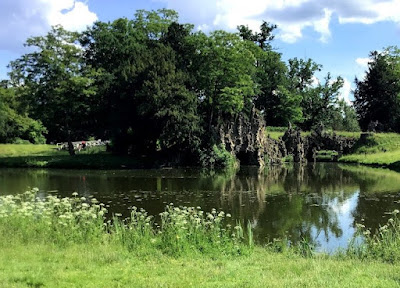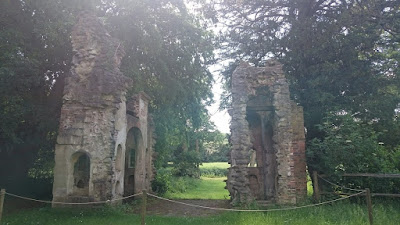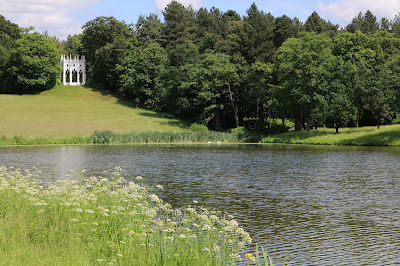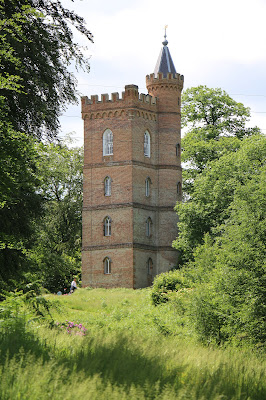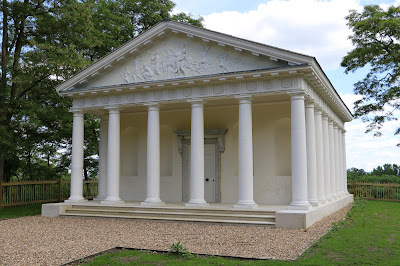 |
| Painshill - view of Gothic temple and five-arch bridge |
Since 1981, the Painshill Park Trust has been working to restore the garden to its Georgian splendour. The garden is open to visitors. For more information see the Painshill website.
Charles Hamilton – creator of Painshill
Painshill was the masterpiece of Charles Hamilton (1704 – 1786), the youngest son of the 6th Earl of Abercorn. Having made the Grand Tour – not once, but twice – Hamilton was inspired to produce a living memento of what he had seen. As the youngest son, he did not have great wealth at his disposal, but he did have good connections. He went to school with Henry Hoare of Stourhead, of the wealthy banking family, and Henry Fox, later 1st Baron Holland. Both men lent him large amounts of money.
In addition, Hamilton’s sister Jane1 was First Lady of the Bedchamber to Princess Augusta of Wales, and most likely the mistress of Princess Augusta’s husband Frederick, George III’s father. Through her influence, Hamilton was appointed Clerk of the Household to Prince Frederick (1738-47) and MP for Truro (1741-47). He was also Receiver General of the Revenues of Minorca from 1743, and when this post was lost in 1756, Henry Fox arranged for him to be given a government pension of £1,200 a year.
Living pictures at Painshill
In 1738, Hamilton acquired some land in the Cobham area and started to build Painshill. The garden was designed to present the visitor with living pictures incorporating a variety of man-made features including a Gothic temple and a crystal grotto. Hamilton created a path around the garden that presented the visitor with different vistas as they walked.
 |
| View of bridge and Gothic Temple at Pains Hill from Select Illustrations of the County of Surrey by Prosser (1828) |
Sir John Parnell wrote in his journal on his visit in 1763:
You enter at a disadvantageous part of the garden by a little old house. Nothing before you but a flat, fine-grassed sheepwalk, with clumps of Scots firs and laurel interspersed with flowering shrubs: these are surrounded with pitched network to prevent the sheep, which are here in abundance, from spoiling the plants. In this plain you wait some time till the footman who opened the gate to you has brought a gardener who conducts you about two hundred yards, when all at once a beautiful country bursts on your eye at one side, and at the other an hill wooded and interspersed with pretty pavilions, which from its distance you are surprised to hear is within the pales of the improvement. You then enter some wilderness work of flowering shrubs which leads to an orangery where are some exotic plants and abundance of oranges. Here the gardener asks each person’s name and formally writes it down in a book for what purpose I cannot say, except that his master may thence make an estimate of what the gardener receives for showing the improvements.2
I have been to see Mr Hamilton's, near Cobham, where he has really made a fine place out of a most cursed hill.3
 |
| View from the Gothic Temple at Pains Hill from Select Illustrations of the County of Surrey by Prosser (1828) |
‘There may be scenes,’ observes a writer in his description of this seat, ‘where nature has done more for herself, but in no place that I ever saw has so much been done for nature as at Pains Hill. The beauty and unexpected variety of the scene, the happy situation, elegant structure, and judicious form of the buildings, the flourishing state, uncommon diversity, and contrasted groupage of the trees, and the contrivance of the water, will not fail to awaken the most pleasing sensations.’4
In his Observations on Modern Gardening (1770), Thomas Whately wrote that Painshill
… is little benefited by external circumstances; but the scenes within itself are both grand and beautiful; and the disposition of the gardens affords frequent opportunities of seeing the several parts, the one from the other, across the park, in a variety of advantageous situations.5
An easy winding descent leads from the Gothic building to the lake, and a broad walk is afterwards continued along the banks, and across an island, close to the water on one hand, and skirted by wood on the other: the spot is perfectly retired; but the retirement is chearful; the lake is calm; but it is full to the brim, and never darkened with shadow; the walk is smooth, and almost level, and touches the very margin of the water; the wood, which secludes all view into the country, is composed of the most elegant trees, full of the lightest greens, and bordered with shrubs and with flowers; and though the place is almost surrounded with plantations, yet within itself it is open and airy; it is embellished with three bridges, a ruined arch, and a grotto; and the Gothic building, still very near, and impending directly over the lake, belongs to the place; but these objects are never visible all together; they appear in succession as the walk proceeds; and their number does not croud the scene which is enriched by their frequency.6
A pioneer of English wine-making
Hamilton planted a vineyard, probably in the early 1740s, and by 1748, the vines were producing grapes. He was a pioneer of English wine-making and sold wine from his vineyard for more than two decades. His attempts at making red wine were not successful but he decided to try again with white wine. In 1748, he employed David Geneste, a Huguenot refugee from Clairac, part of the wine-making region of Bordeaux.
 |
| Painshill vineyard (2018) |
Hamilton claimed that:
The very first year I made white Wine, it nearly resembled the flavour of Champaign; and in two or three years more, as the Vines grew stronger, to my great amazement, my Wine had a finer flavour than the best Champaign I ever tasted … The surest proof I can give of its excellence is, that I have sold it to Wine-merchants for fifty guineas a hogshead.7
The Gothic temple
 |
| The Gothic temple at Pains Hill from Select Illustrations of the County of Surrey by Prosser (1828) |
 |
| Gothic temple, Painshill |
 |
| Interior of Gothic temple, Painshill |
Went again to Mr Charles Hamilton’s at Payne’s hill near Cobham, to see the Gothic building & the Roman ruin. The former is taken from Battey Langley’s book (which does not contain a single design of true or good Gothic) & is made worse by pendent ornaments in the arches, & by being closed on two sides at bottom, with cheeks that have no relation to Gothic. The whole is an unmeaning edifice. In all Gothic designs, they should be made to imitate something that was of that time, a part of a church, a castle, a convent, or a mansion. The Goths never built summer-houses or temples in a garden. This at Mr Hamilton’s stands on the brow of a hill – there an imitation of a fort or watchtower had been proper.8
 |
| Design for a Gothic temple from Gothic architecture, improved by rules and proportions by B & T Langley (1747) |
On the borders of the lake is an artificial ruin, and a mausoleum containing some antiquarian remains brought from Italy.9
Walpole was more complimentary about the ruin than the Gothic temple:
The Ruin is much better imagined, but has great faults. It represents a triumphal Arch, & yet never could have had a column, which would certainly have accompanied so rich a Soffite. Then this Arch is made to have been a Columbarium. You may as well suppose an Alderman’s family buried in Temple bar. Had it been closed behind, & there is no reason it should not, for it leads no where, one might imagine it a private burial-place, tho the fashion uncommon. The upper row of niches in the columbarium are too high, & in a proportion more gothic than Roman. The tessellated pavement unluckily resembles a painted oil-cloth.10
Hamilton used the water of the nearby River Mole to create water features for his garden. Whately described how the lake sat below the Gothic temple:
… an open Gothic building, on the very edge of a high steep, which rises immediately above a fine artificial lake in the bottom: the whole of this lake is never seen at once; but by its form, by the disposition of some islands, and by the trees in them and on the banks, it always seems to be larger than it is.11
The grotto
One of the highlights of Painshill today is the restored crystal grotto. Prosser wrote:
A descending walk to the left of this building [the Gothic temple] conducts to an island, connected by a bridge over the lake. This island is also connected with another by an arch built of the same material as the grotto which adjoins it … The grotto is well designed and admirably executed by the same artist who formed that at Oatlands; its situation, also, is well chosen for a mimic display of those beautiful cavern scenes which nature sometimes presents. Near the entrance and in various situations are masses of artificial rockwork fancifully disposed. 12
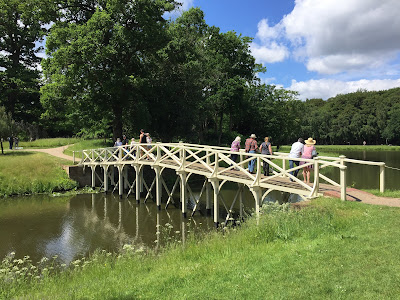 |
| Chinese Bridge, Painshill |
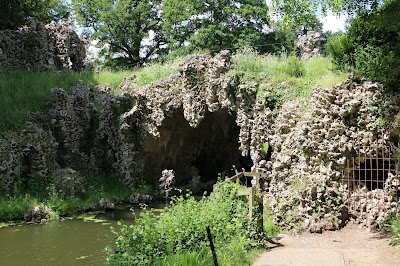 |
| Entrance to the crystal grotto, Painshill |
 |
| Inside the crystal grotto, Painshill |
 |
| View from inside the crystal grotto, Painshill |
 |
| View from inside the crystal grotto, Painshill |
 |
| View from inside the crystal grotto, Painshill |
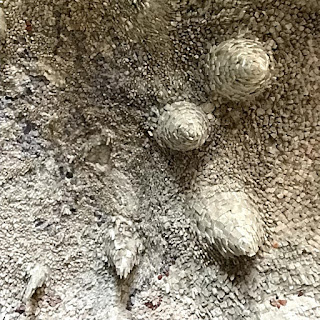 |
| The ceiling of the crystal grotto, Painshill |
 |
| The Woollett bridge, Painshill |
Whately wrote:
A broad river, issuing from the lake, passes under a bridge of five arches near the outlet.13
ir John Parnell wrote:
At about two hundred yards from the water you see the River Mole lying 13 feet beneath you, yet it is raised up by one of the most ingenious wheels I ever saw, and supplies all the water in the improvements. Mr Hamilton brought the invention from some waterwork abroad.14
The current wheel dates from the 1830s.
The hermitage
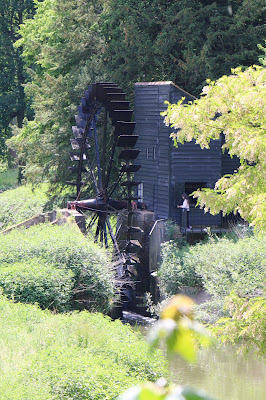 |
| The waterwheel, Painshill |
 |
| The waterwheel, Painshill |
On the side of the hill is couched a low hermitage, encompassed with thicket, and overhung with shade … composed of logs and of roots; the design is as simple as the materials; and the furniture within is old and uncouth; all the circumstances which belong to the character, are retained in the utmost purity, both in the approach and the entrance; in the second room they are suddenly changed for a view of the gardens and the country, which is rich with every appearance of inhabitants and cultivation.15
Hamilton engaged a real hermit to live in the hermitage, but it was not a success.
The hermit, sad to relate, was a failure. He was offered £700 to live a Nebuchadnezzar-like existence in his cell, sleeping on a mat, never speaking a word, and abandoning all the conveniences of a toilet. He would gladly have taken the £700, but threw up his post after three weeks.16
The Gothic tower
Sir John Parnell wrote:
From the wood you enter a walk which leads to the extremity and highest part of the improvements. On it is erected the Belvidere or Gothic castle: it is five storeys high from the ground, with a round staircase at one angle and about 15 feet in the clear. From the upper rooms you command a truly charming scene of this fine cultivated place on two sides, you see to Windsor Forest on another side, and the fourth looks to the heath we came over. It is inconceivable how beautiful Mr Hamilton’s grounds appear, all spotted with pavilions, clumps of evergreens or forest tress, while the rough heath withoutside show what Industry and the Power of Cultivation can do, as most of Mr Hamilton’s was once as rough as it.17
Whately described it:
From the tower on the top of the hill is another prospect, much more extensive, but not more beautiful; the objects are not so well selected, nor seen to so great advantage; some of them are too distant; some too much below the eye; and a large portion of the heath intervenes, which casts a cloud over the view.18
The Temple of Bacchus
… a large Doric building, called the temple of Bacchus, with a fine portico in the front, a rich alto relievo in the pediment, and on each side a range of pilasters: within, it is decorated with many antique busts, and a noble statue of the god in the centre; the room has none of that solemnity which is often affectedly ascribed to the character, but without being gaudy is full of light, of ornament, and splendour.19
The ‘statue of the god’ referred to was a huge marble statue of Bacchus, the god of wine, which was 7 feet tall. Prosser’s description of Painshill in 1828 told of the fate of the statue:
Not far from this [the Turkish tent], amid a scene rich with flowery shrubs and majestic trees, is the temple of Bacchus, a large building of the Doric order, having a portico and a fine alto relieve in the pediment. It formerly contained a celebrated antique colossal statue of Bacchus of great merit, which is said to have cost £3,000. It was afterwards purchased by Mr Beckford, and removed to Fonthill.20
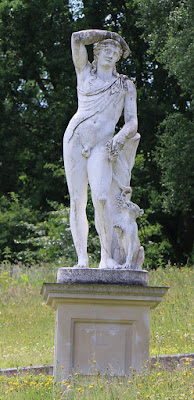 |
| A replica of the statue of Bacchus, Painshill |
The Turkish tent
A Turkish tent is erected on an eminence, commanding a pleasing view of the lake and adjacent scenery. 21
 |
| View from the Gothic temple, Painshill showing the five-arch bridge and the Turkish tent |
The tent is elegantly finished, the back is built and plastered, the top leaded and painted blue, joining a sailcloth marquee that covers all and is painted white with a blue fringe drawn up before in festoons, like Darius’s Tent.22
Whately praised the view from the Turkish tent:
… an open walk through the park; in the way a tent is pitched, upon a fine swell, just above the water, which is seen to greater advantage from this point than from any other.23
Eventually Hamilton’s money problems caught up with him and he was forced to sell Painshill. After visiting in October 1771, John Wesley commented:
And now, after spending his life bringing it to perfection, the grey-headed owner advertises it to be sold! 24
In July 1773, Hamilton sold Painshill to Benjamin Bond Hopkins for £25,000 and moved to the Royal Crescent in Bath. Hamilton died in Bath in 1786 aged 82 and is buried in Bath Abbey.
Hopkins built the house that Hamilton had never got round to building:
The principal front … has its centre adorned with four columns, to which is an ascent by a flight of steps. Connected with the building, on the south side, is a neat private chapel; its windows are ornamented with various subjects painted on glass. On this side is a small flower-garden, with aviary and a well stocked gold and silver fish-pond.25
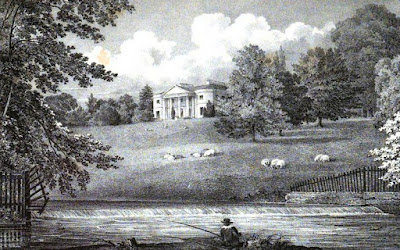 |
| 'Pains Hill' from Select Illustrations of the County of Surrey by Prosser (1828) |
Notes
1. You may be interested to know that Charles Hamilton was connected to Emma Hamilton, the famous mistress of Vice Admiral Lord Horatio Nelson, through his sister Jane. Jane and her husband Lord Archibald Hamilton, a younger brother of James Hamilton, 4th Duke of Hamilton, were the parents of Emma’s husband, Sir William Hamilton.
2. James Sambrook, 'Painshill Park in the 1760s' Garden History vol 8 no.1 (1980) – excerpt from manuscript journal of Sir John Parnell – An account of the many fine seats of nobles I have seen, with other observations, made during my residence in England in 1763.
3. Horace Walpole, Letters from the Hon Horace Walpole to George Montagu Esq (1818) - in a letter from Horace Walpole to George Montagu dated 11 August 1748.
4. George Frederick Prosser, Select Illustrations of the County of Surrey (1828).
5. Thomas Whately, Observations on modern gardening, illustrated by descriptions (1770).
6. Ibid.
7. Sir Edward Barry, Observations Historical, Critical and Medical on the Wines of the Ancients and the Analogy between Them and Modern Wines (1775).
8. Paget Toynbee, ‘Horace Walpole’s Journals of Visits to Country Seats, &c’ The Volume of the Walpole Society, vol. 16 (1927) - entry dated 22 August 1761.
9. Prosser op cit.
10. Toynbee op cit.
11. Whately op cit.
12. Prosser op cit.
13. Whately op cit.
14. Sambrook op cit.
15. Whately op cit.
16. Eric Parker, Highways and Byways in Surrey (1921).
17. Sambrook op cit.
18. Whately op cit.
19. Ibid.
20. Prosser op cit.
21. Ibid.
22. Sambrook op cit.
23. Whately op cit.
24. The World of Fine Wine website – A most Cursed Hill: Painshill and the Beginnings of English Wine
25. Prosser op cit.
Sources used include:
Brayley, Edward Wedlake, A Topographical History of Surrey (1850)
Barry, Sir Edward, Observations, Historical, Critical, and Medical on the Wines of the Ancients: And the Analogy Between Them and Modern wines (1775) pp471-76
Hodges, Alison, 'Painshill Park, Cobham, Surrey (1700-1800): Notes for a History of the Landscape Garden of Charles Hamilton' Garden History vol 2 no.1 1973 pp39-68 JSTOR www.jstor.org/stable/1586476
Langley, Batty & Thomas, Gothic architecture, improved by rules and proportions (1747)
Parker, Eric, Highways and Byways in Surrey (1921)
Prosser, George Frederick, Select Illustrations of the County of Surrey (1828)
Sambrook, James, 'Painshill Park in the 1760s' Garden History vol 8 no.1 1980 p91-106 JSTOR www.jstor.org/stable/1586682
Toynbee, Paget, Horace Walpole's Journals of Visits to Country Seats &c., The Volume of the Walpole Society, vol 16, 1927, pp9-80 JSTOR www.jstor.org/stable/41830706
Walpole, Horace, Letters from the Hon Horace Walpole to George Montagu Esq (1818)
Whately, Thomas, Observations on modern gardening, illustrated by descriptions (1770)
History of Parliament online
Painshill website
The World of Fine Wine website – A most Cursed Hill: Painshill and the Beginnings of English Wine
Last visited June 2018
All photographs © RegencyHistory.net

